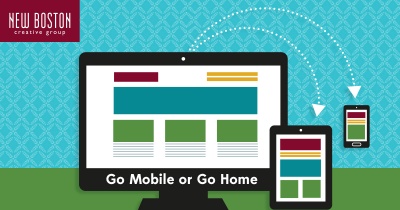Go Mobile or Go Home
by Kristin Brighton on December 7, 2016
Yeah, yeah, yeah. I can see you rolling your eyes. And I feel your pain. I know that the last thing you want to do is redesign the website you felt so proud of in 2012. I mean, you paid a lot of money and you want that investment to last for years and years, right?
Well, it’s been years and years. Mashable declared 2013 the “Year of Responsive Web Design.” So as we approach 2017, if your site hasn’t been retrofitted or redesigned so that it automatically adjusts to the size of the browser window on any and every device, your digital presence has gone the way of chalkboards, milkmen, and flip phones.
You are officially old school — and losing money daily.
If your site isn’t mobile-friendly, the most powerful search engine in the world is penalizing you in its search results. You heard me right. Google gives mobile-friendly websites priority in search rankings over those that are not. So, if your site isn’t fully responsive, then you’re losing out.
Furthermore, consider these stats from Ad Age’s 2016 Mobile Fact Pack:
- American adults aged 18+ consumed an average of more than 12 hours a day of media in 2016.
- This media consumption included nearly 5 hours and 45 minutes of digital media, of which more than 3 hours was on a mobile device. (Time spent talking on a phone is not included.)
- The average amount of time people spent using a desktop or laptop was 2 hours and 11 minutes, nearly an hour less per day than they spent consuming media on a mobile device.
- With the exception of radio, all non-digital media outlets experienced a decline in the amount of time Americans consumed them between 2015 and 2016. (This includes television and all forms of print media.)
- 2.1 billion people around the world have a smartphone.
- In North America, more than 80% of individuals of all ages have at least one mobile phone.
If you think none of this applies to you, then stop and think about your customers. One of the fastest-growing customer bases, the Millennial generation, is gaining wealth and buying power, and moving into key decision-making roles in the workforce. You can no longer dismiss this important demographic.
Born between 1980 and 1996 (so between 20 and 36 years old), Millennials:
- Are the first generation to completely grow up with computers
- Have very little brand loyalty, so they will aggressively compare you to your competitors before buying
- Are savvy online shoppers (Gallup reports that 80% of Millennials shop for clothes, books and other retail items online.)
And don’t think your Facebook page is enough to save you. Gallup says that only 7% of all consumers and 11% of Millennials use social media as a source of information about retailers’ products and services. Of that percentage, Facebook is one small component, along with Twitter, Instagram, Pinterest, Snapchat, LinkedIn, and more. Amid all the noise, retailers’ websites are still the number one place people go to make buying decisions.
The retail landscape is being completely transformed. You can either evolve or become extinct.
So, what would a mobile user think of your website? Can your site be easily read and used on a smartphone? Does it look good on a tablet? If not, then boom! You just lost some money.
Here’s the bottom line…
If your website looks like a teeny, tiny, shrunken version of itself crammed onto the screen of a smartphone where a user can't even press a button, instead of like a bright, inviting, readable, dynamic, visually appealing, scrollable page, then your business is in trouble.
Make it a priority for 2017 to get on the mobile bandwagon. New Boston can guide you through the process, and get you up-to-date.


